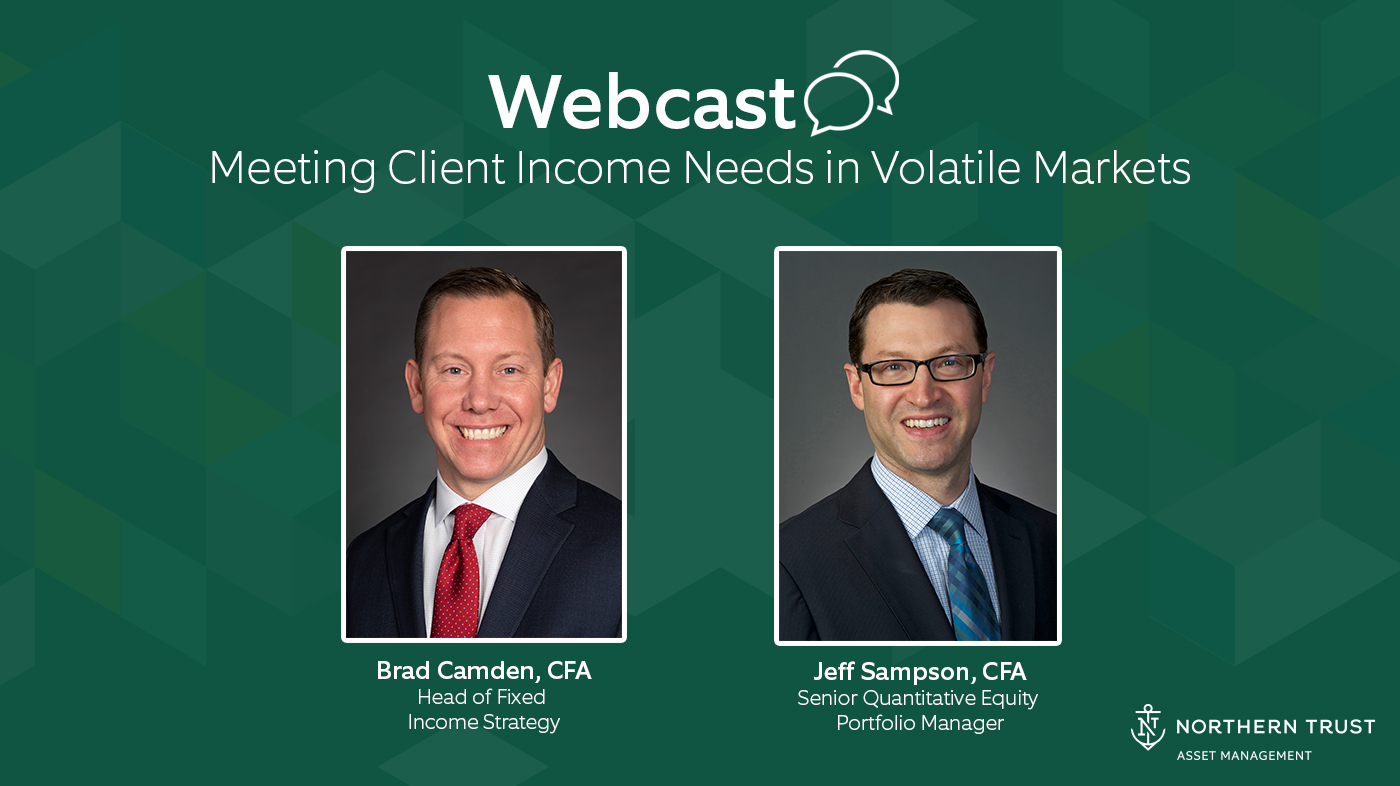Northern Trust Asset Management’s Head of Fixed Income Strategy Brad Camden, Senior Quantitative Equity Portfolio Manager Jeff Sampson, and Head of Intermediary Distribution Michael Natale explore strategies to grow a client’s investment income without incurring additional risk. These approaches are especially relevant during times of market volatility and low-interest rates.
According to Northern Trust Asset Management’s market update, there have been 56 volatility shocks since 2009. These high frequency shocks, defined as a five point or greater move in the volatility index (VIX), indicate that market volatility will likely continue to be the norm. One consequence of global volatility is low interest rates. Northern Trust predicts that the Fed will hold rates at zero for the next five years. This means that in order to achieve client objectives, advisors will have to move away from risk-free assets. From a credit outlook perspective, credit spread widening occurred in a matter of weeks in 2020 as a result of the Covid-19 epidemic. Looking ahead, Northern Trust suggests that investors look beyond fundamentals to technicals, and keep a close eye on the Fed.
Uncertain economic growth is not necessarily a hindrance for investors. Based on Northern Trust’s five-year asset class total return forecast, the 60/40 model has a predicted return of 3.9%. Meanwhile, global real estate and US high yield are expected to return 6.4% and 5.5%, respectively. In the last two decades, more risk is needed to achieve the same returns. This means that investors have been striving to diversify while remaining vigilant to ensure their portfolios can withstand a volatile market.
The Northern Trust team explains that the role of fixed income is to provide diversification from equities, capital preservation, and income. It also plays a critical role in a multi-asset portfolio. High yield is an asset class that is expected to generate a return of 5.5% over five years and 7.0% in 2020. Historically, the high yield asset class has captured 55% of the market upside and only 33% of the downside. For investors seeking short-term opportunities in fixed income, European high yield offers an attractive yield, while maintaining lower defaults than the US high yield. Another option in fixed income is ultra-short which can be used to fulfill liquidity and cash flow needs.
On the equity front, investors are shifting their attention to dividends. Dividend contributions have varied over the years, but they can be a stabilizing force to consider when constructing a portfolio. The team highlights dividends are proven to generate cash flow and high dividend payers are often concentrated in mature industries. Any dividend cuts this year are expected to be focused in specific industries, with total cuts estimated to be around 10%. Northern Trust defines “quality” based on an investment’s management efficiency, profitability, and cash flow. Using this measure, they have determined that lower-quality companies experience greater dividend cuts. This data indicates that investors should consider multiple metrics, like “quality,” when choosing which dividends to pursue. They should also follow a total returns approach and not solely rank investments by dividend yield. Northern Trust emphasizes that the best dividend strategy is to broadly diversify and seek income across the market.
Headquartered in Chicago, Illinois, Northern Trust Asset Management assists clients globally in achieving their long-term growth objectives. The firm serves an array of groups and individuals from corporations to financial advisors to pension funds. Their areas of expertise are asset servicing, investment management, and wealth management. Launched in 1889, Northern Trust is one of the largest banks in the United States with $914B total AUM and the 18th largest asset manager in the world.
To view the full webcast, head here.


